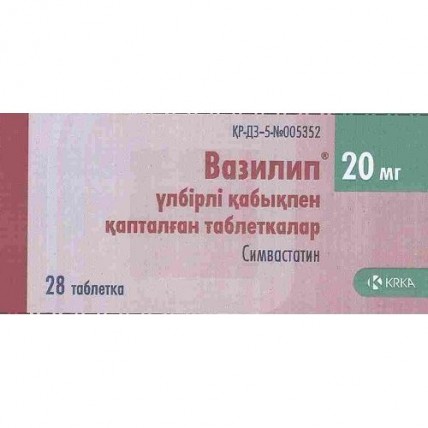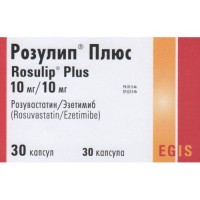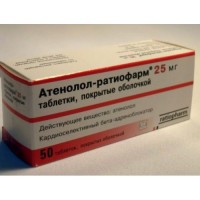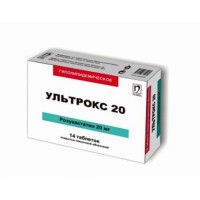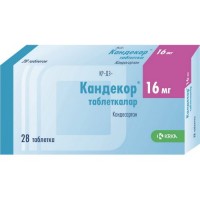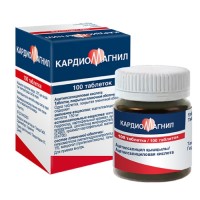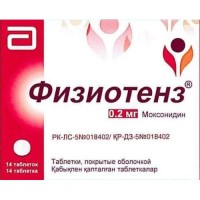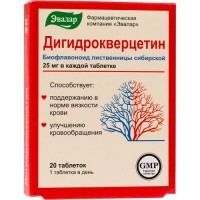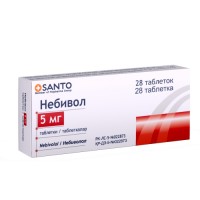Vasilip 28's 20 mg coated tablets
- $22.30
The instruction for medical use
of VAZILIP® medicine
the Trade name
of Vazilip®
the International unlicensed
name Simvastatin Lekarstvennaya
the Tablet form, film coated on 10 mg, 20 mg or 40 mg.
Structure
One tablet contains
active agent - simvastatin 10 mg, 20 mg or 40 mg,
excipients: lactoses monohydrate, starch prezhelatinirovanny, butylhydroxyanisole, anhydrous citric acid, ascorbic acid, starch corn, cellulose microcrystalline, magnesium stearate,
structure of a cover: gipromelloza, talc, propylene glycol, titan dioxide (E171).
The description
of the Tablet of round shape with slightly biconvex surface, film coated white or almost white color, with slanted edges on both sides (for dosages of 10 mg and 20 mg).
Tablets of round shape with slightly biconvex surface, film coated white or almost white color, with slanted edges on both sides and risky on one party (for a dosage of 40 mg).
Pharmacotherapeutic group
Hypolipidemic drugs. HMG-CoA reductase inhibitors.
The code of automatic telephone exchange C10AA01
the Pharmacological
Pharmacokinetics Simvastatin properties is provided in an inactive lactone form which is rather well absorbed from digestive tract from 61% to 85%. After oral administration the maximum therapeutic concentration in blood plasma is reached through – 1.3 - 2.4 h and decreases by 90% in 12 h. Communication with proteins of blood plasma – 98%.
It is metabolized in a liver, has effect of the first passing through a liver (it is generally hydrolyzed in the active form beta hydroxyacid). Elimination half-life of active metabolites makes 1.9 h.
It is generally removed through zheludochno – an intestinal path (60%) in the form of metabolites. About 10 - 15% are removed by kidneys in an inactive form.
The pharmacodynamics
Active agent of the drug Vazilip® is simvastatin which main effect is decrease in content of the general cholesterol and cholesterol of lipoproteins of the low density (LDL) in blood plasma. Вазилип® 3-hydroxy - 3-methyl glutaryl of coenzyme A (GMG-KoA) of reductase, the enzyme catalyzing transformation GMG-KoA into mevalonovy acid (early stage of synthesis of cholesterol) is inhibitor. Вазилип® reduces concentration of the general cholesterol, cholesterol of lipoproteins of the low density (LDL) and triglycerides. Content of cholesterol of lipoproteins of very low density (LPONP) also decreases while the content of cholesterol of lipoproteins of the high density (LPVP) moderately increases. Reduces the content of the general cholesterol and LDL in cases of heterozygous family and single forms of a hypercholesterolemia, at the mixed lipidemia when the increased content of cholesterol is risk factor. Drug reduces the level of the general cholesterol and cholesterol of lipoproteins of the low density (LDL) at patients with coronary heart disease, reducing risk of a myocardial infarction and a lethal outcome for these patients.
The anti-sclerous effect of Vazilipa® is a consequence of impact of drug on walls of vessels and components of blood. Вазилип® changes metabolism of macrophages, oppressing them activation and destruction of atherosclerotic plaques. Вазилип® suppresses synthesis of the isoprenoids which are growth factors at proliferation of smooth muscle cells of an internal cover of vessels. Under the influence of a simvastatin the endothelium - dependent expansion of blood vessels improves.
The therapeutic effect occurs in 2 weeks, the maximum effect is observed in 4 - 6 weeks of treatment.
Indications
- primary hypercholesterolemia of the IIa and IIb types, including a polygenic hypercholesterolemia, a heterozygous hereditary hypercholesterolemia and the mixed lipidemia (drug is used in the form of monotherapy when observance of a diet and other methods of treatment was insufficient).
- prevention of cardiovascular disturbances, at patients with coronary heart disease (stroke or tranzitorny ischemic attacks), delay of progressing of atherosclerosis of coronary vessels, reduction of risk of procedures of revascularization (shunting of coronary arteries and transdermal transluminal angioplasty).
The route of administration and doses
take the Drug inside, once, in the evening.
The recommended dose of Vazilip® for treatment of a hypercholesterolemia varies from 10 mg to 80 mg once a day in the evening.
The hypercholesterolemia
the Recommended initial dose of drug for patients with a hypercholesterolemia, makes 10 mg. The maximum daily dose - 80 mg. It is necessary to carry out changes (selection) of a dose with intervals not less, than in 4 weeks. At most of patients the optimum effect is reached at administration of drug in doses to 20 mg a day.
The homozygous hereditary hypercholesterolemia
At patients with a homozygous hereditary hypercholesterolemia the recommended daily dose of the drug Vazilip® makes 40 mg in the evening or 80 mg in three steps (20 mg - in the morning, 20 mg - in the afternoon and 40 mg - in the evening).
Prevention of cardiovascular disturbances
At treatment of patients with coronary heart disease the effective doses of the drug Vazilip® make 20 - 40 mg once, in the evening. Therefore the recommended initial dose at such patients – 20 mg a day. Changes (selection) of a dose should be carried out with intervals of 4 weeks, if necessary it is possible to increase a dose to 40 mg a day. If LDL content less than 75 mg/dl (1.94 mmol/l), content of the general cholesterol – less than 140 mg/dl (3.6 mmol/l), a dose of drug it is necessary to reduce.
And at patients with a small or moderate renal failure of changes of a dosage of drug it is not required from patients of advanced age. At patients with the profound renal failure (clearance of creatinine less than 30 ml/min.) or receiving treatment by cyclosporine, gemfibrozily, other fibrata or a hypolipidemic dose of Niacinum (more than 1 g/days), the recommended initial dose of the drug Vazilip® makes 5 mg, the maximum daily dose makes 10 mg. Further increase in a dose in such situations is not recommended. In need of increase in a dose the careful observation of such patients is necessary.
Side effects
Seldom (≥ 1/10.000, & lt, 1/1000)
- anemia
- a headache, paresthesia, dizziness, a peripheral neuropathy
- a constipation, an abdominal pain, a meteorism, dyspepsia, diarrhea, nausea, vomiting,
pancreatitis
- hepatitis, jaundice
- rash, an itching, baldness
- a myopathy, a rhabdomyolysis, myalgia, muscular spasms
- an asthenia
- allergic reactions: a Quincke's edema, urticaria, a photosensitization
- a volchanopodobny syndrome, rheumatic polymyalgia, a dermatomyositis, a vasculitis
- arthritis, an arthralgia, fever, inflows of blood to face skin, an asthma and the significant weakness
- thrombocytopenia, an eosinophilia, increase in the blood sedimentation rate (BSR), increase in hepatic transaminases (ALT, nuclear heating plant and GGT) in serum,
increase in alkaline phosphatase and increase in the KFK level in serum
is Very rare (& lt, 1/10.000):
- the memory impairment
- sleep disorders, including insomnia and nightmares
- sexual dysfunction
- a depression
- exceptional cases of an interstitial disease of lungs, especially
at long-term therapy
of the Contraindication
- hypersensitivity to any of drug components,
hypersensitivity to other drugs of a statinovy row
(GMG-KoA-reduktazy inhibitors) in the anamnesis
- liver diseases in an active stage, increase in activity of hepatic
transaminases in blood serum of not clear genesis
- pregnancy and the period of a lactation
- a porphyria
- children's age up to 18 years
Medicinal interactions
Simultaneous use of a simvastatin with Niacinum, cyclosporine, erythromycin, klaritromitsiny, ritonaviry or nefazadony can lead to increase in concentration of a simvastatin in blood serum in this connection development of a myopathy with a rhabdomyolysis and a renal failure is possible. The specified medicines are inhibitors of P450 3A4 cytochrome participating in metabolic transformation of a simvastatin in a liver. The similar situation can arise at a concomitant use of the drug Vazilip® with derivatives of fibroyevy acid.
At a concomitant use with warfarin strengthening of action of the last on blood clotting indicators in this connection risk of developing bleedings increases is possible, with digoxin (single dose) - moderate increase in concentration of digoxin in blood plasma is noted. Therefore careful observation of the patients receiving Vazilip® and digoxin at the same time is necessary.
Colestyraminum and kolestipol reduce bioavailability of a simvastatin (use of a simvastatin is possible in 4 h after intake of the specified drugs, at the same time the additive effect is noted).
The special
instructions Myopathy and a rhabdomyolysis
Treatment simvastatiny, as well as other inhibitors of GMK-KoA-reduktazy, sometimes causes the myopathy which is shown muscle pain, morbidity or weakness, the level of a creatine kinase increases 10 times above the upper bound of norm (UBN). The myopathy sometimes takes the form of a rabdomilioz with an acute renal failure or without, owing to a myoglobinuria, and exceptional cases of a fatal outcome. The risk of a myopathy increases owing to the high level of overwhelming activity of GMK-KoA-reduktazy in plasma.
The risk of a myopathy and rabdomilioz depends on a dosage. Their level in the clinical trials excluding some interacting medicinal products, and patients were under careful observation, there were about 0.03% at a dose of 20 mg, 0.08% at 40 mg and 0.4% at 80 mg.
Measurement of a kreatinofosfokinaza
it is not necessary to take measurement of a kreatinofosfokinaza (KFK) after intensive physical activity or in the presence of other possible alternative reason of increase in KFK as it complicates interpretation of results. If the KFK levels considerably high at the initial level (more than 5 times are relative VGN), it is necessary to measure repeatedly KFK in 5 - 7 days for confirmation of result.
Before an initiation of treatment
before therapy simvastatiny or increase in its dose, patients have to be informed on risk of development of a myopathy and need to see immediately a doctor in case of appearance of inexplicable pain, tension or weakness in muscles. At the patients predisposed to a rabdomilioz it is necessary to be careful. The KFK initial level before therapy needs to be determined in the following situations:
- at elderly patients (70 years are more senior)
- at damage of kidneys
- at a dekompensirovanny hypothyroidism
- at the burdened family anamnesis on hereditary diseases of muscles
- in the presence in the anamnesis of toxic impact on muscles of statines or
fibrat
- in an alcohol abuse.
In such situations it is necessary to estimate possible risk and the expected advantage, and, during therapy the clinical monitoring is recommended. For patients with experience of a myopathy owing to reception of fibrat or statines, treatment by other drug of the same class has to be begun with care. At substantial initial increase of the KFK level (more than 5 times are relative VGN) it is not recommended to appoint drug.
During treatment
At appearance of pain in muscles, weakness or spasms during therapy with statine it is necessary to determine the KFK level. If level (in the absence of intensive physical activity) is increased considerably (more than 5 times are relative VGN), treatment should be stopped. If muscular symptoms are severe and cause discomfort, even at the KFK level less than 5 times of rather upper bound of norm, perhaps, it is necessary to stop treatment. At suspicion on a myopathy the therapy needs to be stopped regardless of the myopathy reason
If symptoms disappear, and the maintenance of KFK returned to normal level, perhaps repeated prescribing of statine or alternative drug of the same class in the minimum clinically effective dose and under careful medical observation.
Therapy simvastatiny needs to be stopped temporarily some days before large surgical interventions.
Measures for reduction of risk of the myopathy caused by medicinal interactions
Risk of a myopathy and a rhabdomyolysis considerably increases at simultaneous use of a simvastatin and powerful CYP3A4 inhibitors (for example, an itrakonazola, a ketokonazola, erythromycin, a klaritromitsin, a telitromitsin, inhibitors of HIV proteases, a nefazodon), gemfibrozit or cyclosporine. The risk of a myopathy and a rhabdomyolysis also increases when sharing fibrat and high doses of niacin (more than 1 g/days) or at simultaneous therapy by Amiodaronum or verapamil with high doses of a simvastatin. The risk also increases a little at co-administration of diltiazem and high doses of a simvastatin (80 mg).
Therefore, use of a simvastatin along with itrakonazoly, ketokonazoly, erythromycin, klaritromitsiny, telitromitsiny, inhibitors of HIV proteases and nefazodony is contraindicated. If it is impossible to refuse therapy by the listed CYP3A4 inhibitors, it is necessary to refrain from purpose of a simvastatin. Simvastatin it is also necessary to combine with care with some other, less strong CYP3A4 inhibitors: cyclosporine, verapamil and diltiazem. It is necessary to avoid a concomitant use of a simvastatin and grapefruit juice.
At the patients accepting cyclosporine gemfibrozit or high doses of niacin (more than 1 g/days), a daily dose of a simvastatin should not exceed 10 mg. It is necessary to avoid co-administration of a simvastatin and a gemfibrozil, except for cases when the expected advantage significantly exceeds potential risk of such medicinal combination. Advantages of the combined use of a simvastatin of 10 mg a day and other fibrat (except the fenofibrat), niacin (more than 1 g/days) or cyclosporine have to be carefully weighed taking into account potential risk of such combinations. The care at a concomitant use of the fenofibrat and a simvastatin as there is a risk of development of a myopathy when prescribing these drugs separately is necessary.
It is necessary to avoid joint reception of a simvastatin in the doses exceeding 20 mg a day with Amiodaronum or verapamil, except for cases when the expected advantage exceeds potential risk of a myopathy.
Influence on a liver
In clinical trials the continuous increases in transaminases in serum (more than 3 times are relative VGN) happened at several adult patients who received simvastatin. When reception of a simvastatin was stopped, transaminase levels usually slowly decreased to initial level.
It is recommended, before an initiation of treatment and further, to conduct a research of function of a liver. In need of increase in a dose to 80 mg, control of function of a liver of patients before increase in a dose, in 3 months after increase and then periodically (for example, 1 time in 6 months) within the first year of treatment is obligatory. Special attention has to be paid to patients with the high level of transaminase of serum. At such patients the measurements of level of transaminase have to be taken immediately and further have to be carried out more often than usually. At the permanent progressing increase in level of transaminase in blood serum by 3 times of rather upper bounds of norm, treatment simvastatiny it has to be stopped.
With care to appoint to the persons abusing alcohol.
As well as at treatment by other gipolipidermichesky agents, it was reported about moderated (less than 3 times are relative VGN) increase in transaminases of serum owing to therapy with simvastatiny. These changes appeared soon after the beginning of therapy with simvastatiny, often were transitional and asymptomatic, and the termination of treatment was not required.
The interstitial disease of lungs
was reported About exceptional cases of an interstitial disease of lungs at treatment by some statines, especially at a long course of treatment. Short wind, dry cough and deterioration in the general state of health (fatigue, loss of weight and fever) can be characteristics. At suspicion on developing of an interstitial disease of lungs, treatment of statine it has to be stopped.
Special information on some
Drug components contains lactose. It is not shown for patients with lactose intolerance problems, a galactosemia or sprue of glucose - galactoses.
Pregnancy and a lactation
of Vazilip® it is contraindicated to pregnant women as the risk of use of drug for a fruit exceeds advantage of drug for the pregnant woman. If during treatment there is pregnancy, drug has to be cancelled, and the woman is warned about possible danger to a fruit.
The feature of influence of medicine on ability to run the vehicle or potentially dangerous mechanisms
® on ability to drive the car and work with mechanisms was not reported About adverse influence of Vazilip.
Overdose
Symptoms: strengthening of side effects.
Treatment - in case of overdose of drug it is necessary to hold the general events: monitoring and maintenance of vital signs, prevention of further absorption of medicine (gastric lavage, intake of activated carbon or depletive).
At development of a myopathy with a rhabdomyolysis and an acute renal failure (rare, but heavy side effect) it is necessary to stop immediately administration of drug and to enter to the patient diuretic and sodium bicarbonate (intravenous infusion). If necessary the hemodialysis is shown. The rhabdomyolysis can cause a hyperpotassemia which can be eliminated with intravenous administration of Calcii chloridum or calcium of a gluconate, infusion of glucose with insulin, use of potassium ion exchangers or, in hard cases, by means of a hemodialysis.
The form of release and packing
On 7 or 10 tablets place in blister strip packaging from a film of PVC/PE/PVDC or PVC/PE/PVDC/PE/PVC and aluminum foil.
On 2, 4 or 12 blister strip packagings (with 7 tablets) or on the 6th blister strip packagings (with 10 tablets) together with the instruction for use in the state and Russian languages place in a pack from cardboard.
To Store storage conditions in original packing at a temperature not over 30 ºС.
To store out of children's reach!
3 years
not to apply a period of storage after a period of storage.
Prescription status
According to the prescription
the Producer
of KRK, of, the place Is new, Shmaryeshka of tsest 6, 8501 the place, Slovenia
the Name and the country of the owner of the registration certificate
of KRK, of Is new, the Place, Slovenia
the Address of the organization accepting in the territory of the Republic of Kazakhstan claims from consumers on quality of products (goods) Representation KRK, of Is new. The place in RKRK, 050059, Almaty, Al-Farabi Ave. 19, body 1b is new, the 2nd etazhtet.: +7 (727) 311 08 09 fax: +7 (727) 311 08 12www.krka.si
To develop
of VAZILIP® medicine
the Trade name
of Vazilip®
the International unlicensed
name Simvastatin Lekarstvennaya
the Tablet form, film coated on 10 mg, 20 mg or 40 mg.
Structure
One tablet contains
active agent - simvastatin 10 mg, 20 mg or 40 mg,
excipients: lactoses monohydrate, starch prezhelatinirovanny, butylhydroxyanisole, anhydrous citric acid, ascorbic acid, starch corn, cellulose microcrystalline, magnesium stearate,
structure of a cover: gipromelloza, talc, propylene glycol, titan dioxide (E171).
The description
of the Tablet of round shape with slightly biconvex surface, film coated white or almost white color, with slanted edges on both sides (for dosages of 10 mg and 20 mg).
Tablets of round shape with slightly biconvex surface, film coated white or almost white color, with slanted edges on both sides and risky on one party (for a dosage of 40 mg).
Pharmacotherapeutic group
Hypolipidemic drugs. HMG-CoA reductase inhibitors.
The code of automatic telephone exchange C10AA01
the Pharmacological
Pharmacokinetics Simvastatin properties is provided in an inactive lactone form which is rather well absorbed from digestive tract from 61% to 85%. After oral administration the maximum therapeutic concentration in blood plasma is reached through – 1.3 - 2.4 h and decreases by 90% in 12 h. Communication with proteins of blood plasma – 98%.
It is metabolized in a liver, has effect of the first passing through a liver (it is generally hydrolyzed in the active form beta hydroxyacid). Elimination half-life of active metabolites makes 1.9 h.
It is generally removed through zheludochno – an intestinal path (60%) in the form of metabolites. About 10 - 15% are removed by kidneys in an inactive form.
The pharmacodynamics
Active agent of the drug Vazilip® is simvastatin which main effect is decrease in content of the general cholesterol and cholesterol of lipoproteins of the low density (LDL) in blood plasma. Вазилип® 3-hydroxy - 3-methyl glutaryl of coenzyme A (GMG-KoA) of reductase, the enzyme catalyzing transformation GMG-KoA into mevalonovy acid (early stage of synthesis of cholesterol) is inhibitor. Вазилип® reduces concentration of the general cholesterol, cholesterol of lipoproteins of the low density (LDL) and triglycerides. Content of cholesterol of lipoproteins of very low density (LPONP) also decreases while the content of cholesterol of lipoproteins of the high density (LPVP) moderately increases. Reduces the content of the general cholesterol and LDL in cases of heterozygous family and single forms of a hypercholesterolemia, at the mixed lipidemia when the increased content of cholesterol is risk factor. Drug reduces the level of the general cholesterol and cholesterol of lipoproteins of the low density (LDL) at patients with coronary heart disease, reducing risk of a myocardial infarction and a lethal outcome for these patients.
The anti-sclerous effect of Vazilipa® is a consequence of impact of drug on walls of vessels and components of blood. Вазилип® changes metabolism of macrophages, oppressing them activation and destruction of atherosclerotic plaques. Вазилип® suppresses synthesis of the isoprenoids which are growth factors at proliferation of smooth muscle cells of an internal cover of vessels. Under the influence of a simvastatin the endothelium - dependent expansion of blood vessels improves.
The therapeutic effect occurs in 2 weeks, the maximum effect is observed in 4 - 6 weeks of treatment.
Indications
- primary hypercholesterolemia of the IIa and IIb types, including a polygenic hypercholesterolemia, a heterozygous hereditary hypercholesterolemia and the mixed lipidemia (drug is used in the form of monotherapy when observance of a diet and other methods of treatment was insufficient).
- prevention of cardiovascular disturbances, at patients with coronary heart disease (stroke or tranzitorny ischemic attacks), delay of progressing of atherosclerosis of coronary vessels, reduction of risk of procedures of revascularization (shunting of coronary arteries and transdermal transluminal angioplasty).
The route of administration and doses
take the Drug inside, once, in the evening.
The recommended dose of Vazilip® for treatment of a hypercholesterolemia varies from 10 mg to 80 mg once a day in the evening.
The hypercholesterolemia
the Recommended initial dose of drug for patients with a hypercholesterolemia, makes 10 mg. The maximum daily dose - 80 mg. It is necessary to carry out changes (selection) of a dose with intervals not less, than in 4 weeks. At most of patients the optimum effect is reached at administration of drug in doses to 20 mg a day.
The homozygous hereditary hypercholesterolemia
At patients with a homozygous hereditary hypercholesterolemia the recommended daily dose of the drug Vazilip® makes 40 mg in the evening or 80 mg in three steps (20 mg - in the morning, 20 mg - in the afternoon and 40 mg - in the evening).
Prevention of cardiovascular disturbances
At treatment of patients with coronary heart disease the effective doses of the drug Vazilip® make 20 - 40 mg once, in the evening. Therefore the recommended initial dose at such patients – 20 mg a day. Changes (selection) of a dose should be carried out with intervals of 4 weeks, if necessary it is possible to increase a dose to 40 mg a day. If LDL content less than 75 mg/dl (1.94 mmol/l), content of the general cholesterol – less than 140 mg/dl (3.6 mmol/l), a dose of drug it is necessary to reduce.
And at patients with a small or moderate renal failure of changes of a dosage of drug it is not required from patients of advanced age. At patients with the profound renal failure (clearance of creatinine less than 30 ml/min.) or receiving treatment by cyclosporine, gemfibrozily, other fibrata or a hypolipidemic dose of Niacinum (more than 1 g/days), the recommended initial dose of the drug Vazilip® makes 5 mg, the maximum daily dose makes 10 mg. Further increase in a dose in such situations is not recommended. In need of increase in a dose the careful observation of such patients is necessary.
Side effects
Seldom (≥ 1/10.000, & lt, 1/1000)
- anemia
- a headache, paresthesia, dizziness, a peripheral neuropathy
- a constipation, an abdominal pain, a meteorism, dyspepsia, diarrhea, nausea, vomiting,
pancreatitis
- hepatitis, jaundice
- rash, an itching, baldness
- a myopathy, a rhabdomyolysis, myalgia, muscular spasms
- an asthenia
- allergic reactions: a Quincke's edema, urticaria, a photosensitization
- a volchanopodobny syndrome, rheumatic polymyalgia, a dermatomyositis, a vasculitis
- arthritis, an arthralgia, fever, inflows of blood to face skin, an asthma and the significant weakness
- thrombocytopenia, an eosinophilia, increase in the blood sedimentation rate (BSR), increase in hepatic transaminases (ALT, nuclear heating plant and GGT) in serum,
increase in alkaline phosphatase and increase in the KFK level in serum
is Very rare (& lt, 1/10.000):
- the memory impairment
- sleep disorders, including insomnia and nightmares
- sexual dysfunction
- a depression
- exceptional cases of an interstitial disease of lungs, especially
at long-term therapy
of the Contraindication
- hypersensitivity to any of drug components,
hypersensitivity to other drugs of a statinovy row
(GMG-KoA-reduktazy inhibitors) in the anamnesis
- liver diseases in an active stage, increase in activity of hepatic
transaminases in blood serum of not clear genesis
- pregnancy and the period of a lactation
- a porphyria
- children's age up to 18 years
Medicinal interactions
Simultaneous use of a simvastatin with Niacinum, cyclosporine, erythromycin, klaritromitsiny, ritonaviry or nefazadony can lead to increase in concentration of a simvastatin in blood serum in this connection development of a myopathy with a rhabdomyolysis and a renal failure is possible. The specified medicines are inhibitors of P450 3A4 cytochrome participating in metabolic transformation of a simvastatin in a liver. The similar situation can arise at a concomitant use of the drug Vazilip® with derivatives of fibroyevy acid.
At a concomitant use with warfarin strengthening of action of the last on blood clotting indicators in this connection risk of developing bleedings increases is possible, with digoxin (single dose) - moderate increase in concentration of digoxin in blood plasma is noted. Therefore careful observation of the patients receiving Vazilip® and digoxin at the same time is necessary.
Colestyraminum and kolestipol reduce bioavailability of a simvastatin (use of a simvastatin is possible in 4 h after intake of the specified drugs, at the same time the additive effect is noted).
The special
instructions Myopathy and a rhabdomyolysis
Treatment simvastatiny, as well as other inhibitors of GMK-KoA-reduktazy, sometimes causes the myopathy which is shown muscle pain, morbidity or weakness, the level of a creatine kinase increases 10 times above the upper bound of norm (UBN). The myopathy sometimes takes the form of a rabdomilioz with an acute renal failure or without, owing to a myoglobinuria, and exceptional cases of a fatal outcome. The risk of a myopathy increases owing to the high level of overwhelming activity of GMK-KoA-reduktazy in plasma.
The risk of a myopathy and rabdomilioz depends on a dosage. Their level in the clinical trials excluding some interacting medicinal products, and patients were under careful observation, there were about 0.03% at a dose of 20 mg, 0.08% at 40 mg and 0.4% at 80 mg.
Measurement of a kreatinofosfokinaza
it is not necessary to take measurement of a kreatinofosfokinaza (KFK) after intensive physical activity or in the presence of other possible alternative reason of increase in KFK as it complicates interpretation of results. If the KFK levels considerably high at the initial level (more than 5 times are relative VGN), it is necessary to measure repeatedly KFK in 5 - 7 days for confirmation of result.
Before an initiation of treatment
before therapy simvastatiny or increase in its dose, patients have to be informed on risk of development of a myopathy and need to see immediately a doctor in case of appearance of inexplicable pain, tension or weakness in muscles. At the patients predisposed to a rabdomilioz it is necessary to be careful. The KFK initial level before therapy needs to be determined in the following situations:
- at elderly patients (70 years are more senior)
- at damage of kidneys
- at a dekompensirovanny hypothyroidism
- at the burdened family anamnesis on hereditary diseases of muscles
- in the presence in the anamnesis of toxic impact on muscles of statines or
fibrat
- in an alcohol abuse.
In such situations it is necessary to estimate possible risk and the expected advantage, and, during therapy the clinical monitoring is recommended. For patients with experience of a myopathy owing to reception of fibrat or statines, treatment by other drug of the same class has to be begun with care. At substantial initial increase of the KFK level (more than 5 times are relative VGN) it is not recommended to appoint drug.
During treatment
At appearance of pain in muscles, weakness or spasms during therapy with statine it is necessary to determine the KFK level. If level (in the absence of intensive physical activity) is increased considerably (more than 5 times are relative VGN), treatment should be stopped. If muscular symptoms are severe and cause discomfort, even at the KFK level less than 5 times of rather upper bound of norm, perhaps, it is necessary to stop treatment. At suspicion on a myopathy the therapy needs to be stopped regardless of the myopathy reason
If symptoms disappear, and the maintenance of KFK returned to normal level, perhaps repeated prescribing of statine or alternative drug of the same class in the minimum clinically effective dose and under careful medical observation.
Therapy simvastatiny needs to be stopped temporarily some days before large surgical interventions.
Measures for reduction of risk of the myopathy caused by medicinal interactions
Risk of a myopathy and a rhabdomyolysis considerably increases at simultaneous use of a simvastatin and powerful CYP3A4 inhibitors (for example, an itrakonazola, a ketokonazola, erythromycin, a klaritromitsin, a telitromitsin, inhibitors of HIV proteases, a nefazodon), gemfibrozit or cyclosporine. The risk of a myopathy and a rhabdomyolysis also increases when sharing fibrat and high doses of niacin (more than 1 g/days) or at simultaneous therapy by Amiodaronum or verapamil with high doses of a simvastatin. The risk also increases a little at co-administration of diltiazem and high doses of a simvastatin (80 mg).
Therefore, use of a simvastatin along with itrakonazoly, ketokonazoly, erythromycin, klaritromitsiny, telitromitsiny, inhibitors of HIV proteases and nefazodony is contraindicated. If it is impossible to refuse therapy by the listed CYP3A4 inhibitors, it is necessary to refrain from purpose of a simvastatin. Simvastatin it is also necessary to combine with care with some other, less strong CYP3A4 inhibitors: cyclosporine, verapamil and diltiazem. It is necessary to avoid a concomitant use of a simvastatin and grapefruit juice.
At the patients accepting cyclosporine gemfibrozit or high doses of niacin (more than 1 g/days), a daily dose of a simvastatin should not exceed 10 mg. It is necessary to avoid co-administration of a simvastatin and a gemfibrozil, except for cases when the expected advantage significantly exceeds potential risk of such medicinal combination. Advantages of the combined use of a simvastatin of 10 mg a day and other fibrat (except the fenofibrat), niacin (more than 1 g/days) or cyclosporine have to be carefully weighed taking into account potential risk of such combinations. The care at a concomitant use of the fenofibrat and a simvastatin as there is a risk of development of a myopathy when prescribing these drugs separately is necessary.
It is necessary to avoid joint reception of a simvastatin in the doses exceeding 20 mg a day with Amiodaronum or verapamil, except for cases when the expected advantage exceeds potential risk of a myopathy.
Influence on a liver
In clinical trials the continuous increases in transaminases in serum (more than 3 times are relative VGN) happened at several adult patients who received simvastatin. When reception of a simvastatin was stopped, transaminase levels usually slowly decreased to initial level.
It is recommended, before an initiation of treatment and further, to conduct a research of function of a liver. In need of increase in a dose to 80 mg, control of function of a liver of patients before increase in a dose, in 3 months after increase and then periodically (for example, 1 time in 6 months) within the first year of treatment is obligatory. Special attention has to be paid to patients with the high level of transaminase of serum. At such patients the measurements of level of transaminase have to be taken immediately and further have to be carried out more often than usually. At the permanent progressing increase in level of transaminase in blood serum by 3 times of rather upper bounds of norm, treatment simvastatiny it has to be stopped.
With care to appoint to the persons abusing alcohol.
As well as at treatment by other gipolipidermichesky agents, it was reported about moderated (less than 3 times are relative VGN) increase in transaminases of serum owing to therapy with simvastatiny. These changes appeared soon after the beginning of therapy with simvastatiny, often were transitional and asymptomatic, and the termination of treatment was not required.
The interstitial disease of lungs
was reported About exceptional cases of an interstitial disease of lungs at treatment by some statines, especially at a long course of treatment. Short wind, dry cough and deterioration in the general state of health (fatigue, loss of weight and fever) can be characteristics. At suspicion on developing of an interstitial disease of lungs, treatment of statine it has to be stopped.
Special information on some
Drug components contains lactose. It is not shown for patients with lactose intolerance problems, a galactosemia or sprue of glucose - galactoses.
Pregnancy and a lactation
of Vazilip® it is contraindicated to pregnant women as the risk of use of drug for a fruit exceeds advantage of drug for the pregnant woman. If during treatment there is pregnancy, drug has to be cancelled, and the woman is warned about possible danger to a fruit.
The feature of influence of medicine on ability to run the vehicle or potentially dangerous mechanisms
® on ability to drive the car and work with mechanisms was not reported About adverse influence of Vazilip.
Overdose
Symptoms: strengthening of side effects.
Treatment - in case of overdose of drug it is necessary to hold the general events: monitoring and maintenance of vital signs, prevention of further absorption of medicine (gastric lavage, intake of activated carbon or depletive).
At development of a myopathy with a rhabdomyolysis and an acute renal failure (rare, but heavy side effect) it is necessary to stop immediately administration of drug and to enter to the patient diuretic and sodium bicarbonate (intravenous infusion). If necessary the hemodialysis is shown. The rhabdomyolysis can cause a hyperpotassemia which can be eliminated with intravenous administration of Calcii chloridum or calcium of a gluconate, infusion of glucose with insulin, use of potassium ion exchangers or, in hard cases, by means of a hemodialysis.
The form of release and packing
On 7 or 10 tablets place in blister strip packaging from a film of PVC/PE/PVDC or PVC/PE/PVDC/PE/PVC and aluminum foil.
On 2, 4 or 12 blister strip packagings (with 7 tablets) or on the 6th blister strip packagings (with 10 tablets) together with the instruction for use in the state and Russian languages place in a pack from cardboard.
To Store storage conditions in original packing at a temperature not over 30 ºС.
To store out of children's reach!
3 years
not to apply a period of storage after a period of storage.
Prescription status
According to the prescription
the Producer
of KRK, of, the place Is new, Shmaryeshka of tsest 6, 8501 the place, Slovenia
the Name and the country of the owner of the registration certificate
of KRK, of Is new, the Place, Slovenia
the Address of the organization accepting in the territory of the Republic of Kazakhstan claims from consumers on quality of products (goods) Representation KRK, of Is new. The place in RKRK, 050059, Almaty, Al-Farabi Ave. 19, body 1b is new, the 2nd etazhtet.: +7 (727) 311 08 09 fax: +7 (727) 311 08 12www.krka.si
To develop
